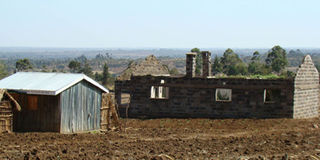Slow recovery from the ashes of a violent past

The shells of burned out buildings and the make-shift timber houses built for victims of post-election violence are still a common sight in Uasin Gishu county. Photo/JARED NYATAYA
Post-election violence has taken a heavy toll on the economy of Uasin Gishu.
From the towns to the villages, people are still living with the consequences of the madness that engulfed Kenya following the disputed 2007 presidential election.
Uasin Gishu was one of the most affected by the violence with up to 90 per cent of business premises in some trading centres were destroyed.
Nowhere is this more visible than the centres in rural areas. From Burnt Forest to Soy and Kondoo to Mwamba, the story is of a people trying hard to pick up the pieces of the violent past and move on.
There are many centres that have reconstructed burned out buildings. On the Eldoret-Kitale road, places like Soy and Nangili are almost back to normal, at least as far as physical reconstruction is concerned.
Soy, which lost nearly 80 per cent of its commercial premises in the mayhem has reconstructed almost all of them and business is once again up and running.
In Eldoret town, Uasin Gishu’s famous sons and daughters — the world beating athletes — are pouring money in. But many other centres have suffered massive capital flight.
Then there is the small matter of the Ocampo Six. Eldoret North MP William Ruto, who is among those headed to the Hague as prime suspects in the violence, is Uasin Gishu’s most famous political son and the debate around his fate is not helping matters.
In many parts of the county, people are unsure of what the future holds for them. Underlying an uneasy calm are the old feelings of hostility that are, for example, fueling a bid by some Kalenjin people to change names of places they say were given by immigrant communities.
From Kondoo Farm, the border between Baringo and Uasin Gishu, effects of post-election violence still loom large.
There is hope
Driving all the way, a stretch of 42 kilometres to Eldoret, the shells of burnt out buildings, and the make-shift timber homes built by Kenya Red Cross can be seen.
They house the victims of violence, whose homes were burnt during the mayhem that followed the last disputed General Election. But there is also hope.
Those who have returned, three years on, have been busy preparing land to plant crops for the season. Ploughed land and newly built houses are evidence that the county is rising from the ashes.
The trading centres which were once vibrant – Kondoo, Burnt Forest, Cheptiret, Keita and Lorian – are still smarting however. In Kondoo trading centre at the eastern end of the county, only the foundations of the shops that were burnt remain.
A few have been repaired while some business people have decamped. John Kariuki, aged 59, of Kondoo summed it up:
“Some people have returned; others only come in to plough land and go away; some have stayed away monitoring the government’s efforts in assisting people to rebuild their houses. It’s wait and see.”
Kondoo Farm, which belonged to the African Development Corporation had one of the biggest settlements in Uasin Gishu inhabited by Kikuyu, Luhya, Kisii and Nandi before the violence.
It had seven blocks in which they were settled shortly after Independence. In Ng’arua next to it, which was hit hard by the violence, life is slowly returning with new buildings coming up.
However, now fear and uncertainty is setting in with the polarised politics associated with disagreements within the ruling coalition over the fate of the Ocampo Six.
Mr James Ngugi, 61, whose house was burnt but who has returned is pensive when asked about future coexistence. “We have peace now, but we do not know what will happen during next year’s election,” he said.
His comment came in spite of the Government having built 32 police posts in the area. They are referred to locally as Green Posts because of the colour of the iron sheets from which they were made … a colour the locals see as signifying peace.
Mr Samuel Lelei, 34, a teacher, estimated that at least 40 per cent of the people had returned to their farms. A further 30 per cent had sold their land and moved out, never to return.
That can be seen at Burnt Forest which previously was an overpopulated town with vibrant business. Today, fewer than half of the businesses have reopened and the population has thinned.
Some of the shops that were burnt and are yet to be repaired belonged to prominent people. Hawking and the open air market on the highway which were common at Burnt Forest is yet to resume fully.
Fewer people can be seen moving around with less goods than before. However, food production in the county has not been affected. A steady supply of maize, potatoes and vegetables still flows.
The land has been ploughed and the planting is going on throughout the county. If the rains behave, at least there will be food. That is, unless it goes up in smoke the stores again.




